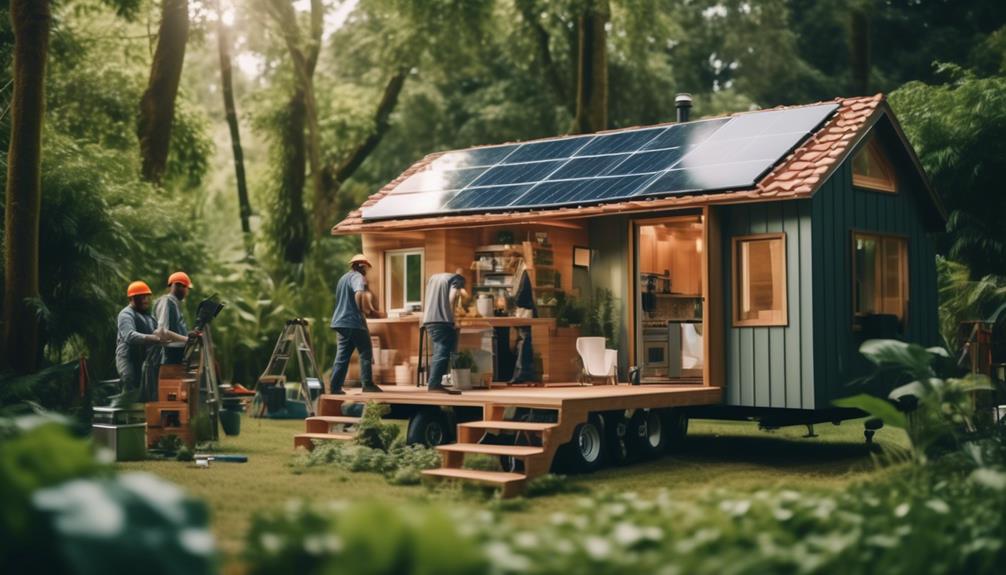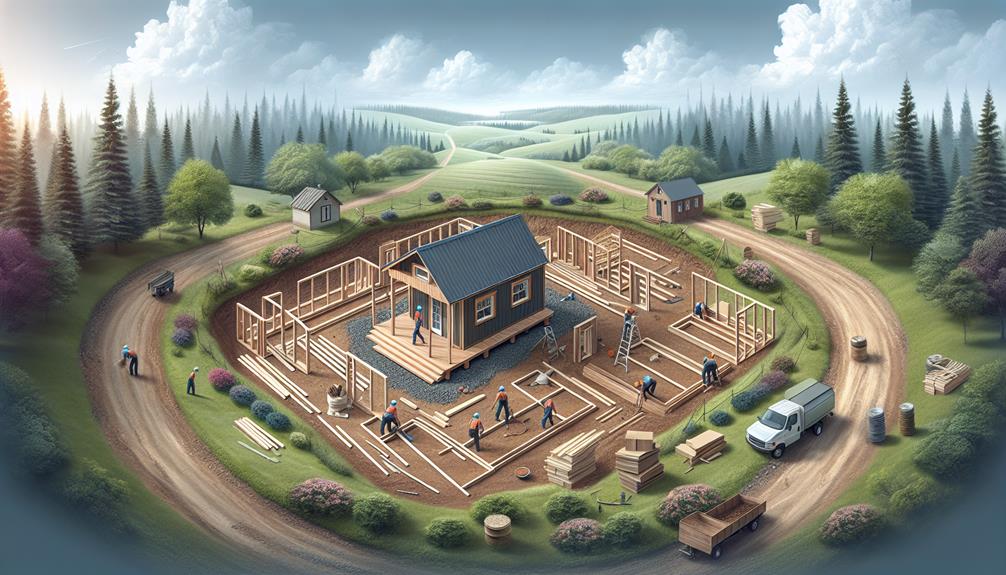On average, building a tiny home requires about 500 hours, a figure that might surprise you given their compact size.
You're contemplating embarking on this journey, but have you considered the myriad of steps and decisions that could stretch this timeline?
From conceptualizing your ideal space to hammering the final nail, each phase is pivotal and can either streamline your process or set you back if not approached with due diligence.
You'll need to navigate the maze of permits, source materials efficiently, and adapt to the unexpected challenges that inevitably arise.
As you stand at the precipice of this adventure, ask yourself if you're ready to plan meticulously, work tirelessly, and, most importantly, possess the patience to see your diminutive dwelling through to completion.
Key Takeaways
- Proper planning and design are crucial for the successful construction of a tiny home.
- Understanding and complying with local zoning laws and obtaining necessary permits is essential.
- Site preparation and choosing the right foundation are important for the stability and longevity of the tiny house.
- Paying attention to detail during construction and installation is necessary to create a functional and livable space.
Conceptualization and Design
When designing your tiny home, it's crucial to select a precise design tool, such as a computer program or graph paper, to ensure the accuracy of your plans. If you lack construction experience, stick to simple dimensions to streamline the building process.
You must accurately plan the placement of doors, windows, and appliances to facilitate precise plumbing and electrical work. Considering building a tiny house in an urban area? Submit your plans to a zoning board early in the design phase to comply with regulations for tiny homes.
Moreover, strategically position windows and doors to maximize natural light and ventilation. This attention to detail during the conceptualization and design phase is a cornerstone of the tiny house movement, endorsed by advocates like Tiny House Nation, Tumbleweed Tiny House, and the American Tiny House Association.
Permitting and Legalities
Having meticulously designed your tiny home, you'll now need to navigate the complexities of permits and legal requirements to ensure your project adheres to all local regulations. Here's what you should focus on:
- Zoning: Investigate local zoning laws to determine where you can legally situate your tiny house. New zoning regulations may affect tiny houses differently, so stay updated.
- Permitting: Secure the necessary building permits, including special permits for tiny homes. This often includes electrical and plumbing permits to ensure your home is up to code.
- Community Compliance: If you're eyeing a place like the Rockledge Tiny House Community or any tiny house village, ensure your build complies with their standards and any HOA rules.
Being methodical about these permitting and legalities is crucial for tiny house enthusiasts. It's the foundation that supports your innovative lifestyle.
Site Preparation and Foundation

Before laying the cornerstone of your tiny home, it's essential to prepare the site and lay a solid foundation. This process begins with clearing any debris and vegetation to ensure a perfectly level base.
The time it takes to build your tiny house's basic structure hinges on this initial phase, which might vary depending on the site's initial condition. When it comes to building a tiny home, selecting the appropriate foundation—be it a concrete slab or concrete piers—is crucial. This choice supports the house's stability and weight-bearing needs.
Moreover, you must secure the foundation to prevent animals from nesting underneath. Methodical planning here not only streamlines the subsequent phases of building but also lays the groundwork for a tiny house that stands the test of time.
Construction and Assembly
Embarking on the construction and assembly phase of your tiny home, you'll be investing approximately 500 hours of hands-on work, which can be significantly reduced with a partner's help. The process is a nod to the pioneers of tiny living, like Lloyd Kahn and Bob Easton, who paved the way with their first tiny house explorations.
Your living space will come together as follows:
- Planning: Diligently design your Small House, considering every square inch.
- Efficiency: Use the right tools for swift construction, like a miter saw for precise cuts.
- Detail: Focus on the installation of Interior Walls, ensuring a seamless and functional space.
As you build, remember the history of the tiny house movement, celebrating simple living through your innovative creation.
Installation and Finishing Touches

As you transition into the installation and finishing phase, meticulous attention to framing walls, securing the roof, and ensuring proper insulation will shape your tiny home into a livable masterpiece.
Over the next two months, you'll delve into the nuances of installation and finishing touches that set apart your cozy abode from a mere Big House. Tiny House Hunters often underscore the importance of precision during this stage.
Make sure to tackle electrical and plumbing with a methodical approach, adhering to safety and durability standards. If mobility is your aim, factor in the unique challenges it presents.
Follow-up comments on new posts from experts like Lester Walker can help you learn everything needed for this journey.
We really appreciate your dedication to innovation, ensuring each step is a stride towards perfection.
Frequently Asked Questions
How Long Does a Tiny House Take to Build?
You'll need about 500 hours to build your tiny house, balancing design considerations, material choices, and budget planning, while navigating zoning laws, selecting a foundation, and integrating sustainability features and custom furnishings.
What Are the Steps to Building a Tiny House?
Just as you'd meticulously plan a dream trip, you'll navigate design considerations, select materials, and optimize space. You'll tackle zoning laws, utility connections, custom features, and choose roof styles, interior layouts, and exterior finishes for your tiny house.
What Is the History of Tiny Homes?
You'll find tiny house origins stem from a mix of cultural influences and the minimalist movement. They tackle housing affordability, legal challenges, and environmental impact while embodying the downsizing trend and mobile living.
How Fast Can You Build a Small House?
Building your small house is a race with many hurdles: speed factors, DIY assembly, prefab options, and zoning challenges. Material selection, budget constraints, design complexity, seasonal impacts, contractor availability, and skill level all shape your timeline.
Conclusion
You've dotted your i's and crossed your t's, meticulously crafting your tiny home from the ground up. The journey from blueprints to the last lick of paint has certainly been no small feat.
As you hammer in the final nail, remember that Rome wasn't built in a day, and neither was your cozy haven. Take pride in every square foot; your dedication has transformed a dream into a tangible, livable masterpiece.
Welcome home!

